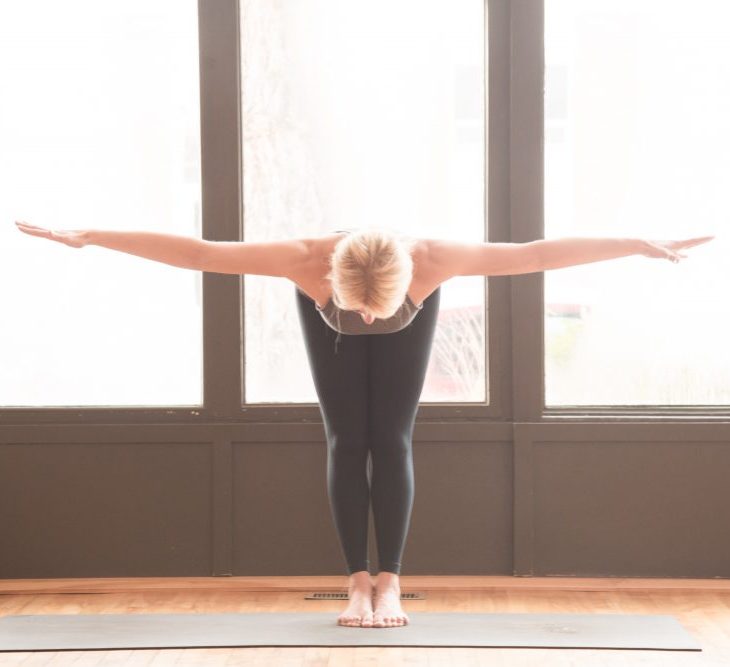[one_third] [/one_third][two_third_last padding=”2% 0 0 0″]Yogi, Brooke Musat, joins us with insight from our Seasons of Greatness, Winter Workshop on how to use failure as a way to reinvent your goals after we’ve all had blunders with our New Year’s Resolutions. Get curiosity, relax your standards, and negotiate with yourself! Photography by Ann Whittaker
[/one_third][two_third_last padding=”2% 0 0 0″]Yogi, Brooke Musat, joins us with insight from our Seasons of Greatness, Winter Workshop on how to use failure as a way to reinvent your goals after we’ve all had blunders with our New Year’s Resolutions. Get curiosity, relax your standards, and negotiate with yourself! Photography by Ann Whittaker
It’s no longer the season of New Year’s Resolutions, instead, it’s that tricky time of year when resolutions of the New Year start to lose their “newness” and motivation starts to dry up. If your start of February is anything like mine, you may have found yourself failing to stick to what you promised yourself you’d stick to in January, and swore you’d stick to throughout the year. That’s okay, a lot of us are in the same boat, and actually, I am encouraging you to continue to fail.
Yup, that is right, I think you should fail more often. Build a familiarity with failure, and generally get more comfortable with committing to do so.
Just saying “fail” out loud feels slightly taboo, maybe it’s because it’s a 4 letter word that begins with an “F”, or maybe it’s the weight the word carries. “Fail” is defined as “being unsuccessful in achieving one’s goal.” Yikes! Just reading that might make your shoulders slump, your lip droop, or your stomach begin to turn. The definition of “fail” is 2 parted, with an element of expectation and an element of disappointment. But what I think the dictionary’s definition doesn’t include, is the importance of failure in achieving one’s goal.
[/two_third_last]
[full_width]Before successfully inventing the light bulb, Thomas Edison failed 10,000 times. When asked about his number of failures, he said “I have not failed. I’ve just found 10,000 ways that won’t work.”
Failure lets us know we must amend, redefine, adjust, reroute, modify, alter, revise, and so forth. Each failure is a breadcrumb on your path to success, a nod from the universe you are 1 step closer, and an opportunity for you to reevaluate or pause.
So how do you begin to build a familiarity with failure? Read below for 3 tips that may help. [/full_width]
[full_width]GET CURIOUS
When you fail, because you will, we all fail, get curious about WHY you failed. If, for example, you failed by falling out of a balancing yoga pose, investigate whether you fell forward, backward, or to one side. If you fell forward, you need to lean less forward, if you fell backward, you need to lean more forward, and if you fell to one side, you need to find strength in the opposite side for which you fell. This example may seem obvious, but this type of investigation is important and 100% appropriate when deciding your next move.
Try the sequence below, but keep curiosity top of mind. If you can’t get curious about poses you’ve done a million times, think about how you can make them feel different. Maybe try thinking about how 1 particular body part is positioned in a pose, stare at that body part, push down, pull up, or direct your breathe toward it. Take time to explore the boundaries of each pose. If this doesn’t work, try adding weights to the hands or feet. If you can commit to remaining curious, you’re sure to make a better next step.
“We keep moving forward, opening up new doors and doing new things, because we’re curious…and curiosity keeps leading us down new paths.” – Walt Disney [/full_width]
[one_half padding=”7% 0 0 0″]o Upward Salute Pose
o Standing Forward Bend
o ½ Standing Forward Bend with arms out to the sides (3X)
o Focus on squeezing shoulder blades together (pictured)
o Chair Pose with feet hip distance
o Bring hands to the outside of the knees (push hands into knees and knees into hands)
o Standing Forward Bend with alternating bent knees
o High Plank
o Four-Limbed Staff Pose
o Downward Dog with legs turned out and then in
o 3 Legged Downward Dog
o Low Lunge with knee down
o High Plank
o Four-Limbed Staff Pose
o Sphinx, Cobra, or Upward Facing Dog
o Repeat sequence on opposite side. [/one_half][one_half_last] [/one_half_last]
[/one_half_last]
[full_width]RELAX THE PROBLEM
If you’ve experienced failure because you were unable to solve the problem right in front of you, then this tip is for you. Inspired by the science and application of algorithms, this tip reminds us that sometimes success can’t be achieved through intensity, but rather finds its way to us when we are relaxed.
Have you ever focused so hard on solving a problem, decided to give up after a significant period of time, then later, when you’re completely unfocused on solving the problem, the solution comes to you? If you’re nodding your head “yes”, then try this sequence. Each of the poses in this sequence have an advanced version, and slightly less advanced version. Try the advanced version first (it will appear first in the sequence), if you fail at embodying it comfortably and safely, then “relax the problem” and go for the less advanced variation. Give yourself permission to fail, and you might be surprised how “permission” temporally allows relaxation to sneak in.
“When we give ourselves permission to fail, we, at the same time, give ourselves permission to excel.”
– Eloise Ristad[/full_width]
[one_half] [/one_half][one_half_last padding=”11% 0 0 0″]o Dolphin or Short Downward Dog (Step feet 6-12 inches closer to hands)
[/one_half][one_half_last padding=”11% 0 0 0″]o Dolphin or Short Downward Dog (Step feet 6-12 inches closer to hands)
o Low lunge (Transition Pose)
o Crescent Lunge or Crescent Lunge with back knee down
o Revolved Side Angle or Revolved Side Angle with back knee down
o High Plank or Forearm Plank
o Downward Dog (Transition Pose)
o Warrior II with hands reaching toward the diagonal or traditional Warrior II (pictured)
o Side Angle with hand on mat or Side Angle with hand on block
o Triangle with hand on shin/mat or Triangle with hand on block
o ½ Moon or ½ Moon with hand on block
o Flow to Downward Dog
o Repeat sequence on opposite side.[/one_half_last]
[full_width]BE WILLING TO NEGOTIATE WITH YOURSELF
If you are that individual who sets the same goal ever New Years, and you fail every year, this tip is dedicated to you. It’s clear, the goal you make every year, isn’t going to pan out exactly as you imagined. Your failure to achieve that goal year after year, is a clue that you need negotiate with yourself.
What about the goal would you being willing to reshape, reframe, or redefine? Let’s say your goal was to run 10 miles each week, but by mid-February you’ve consistently only run 7 miles each week. Clearly, you’ve failed at achieving your initial goal, but instead of getting down on yourself, take the hint from the universe, and use the failure as an opportunity to reflect on the goal. Maybe, you’d be okay with running an average of 10 miles each week. In a month, that could be 2 weeks at 7 miles, 1 week at 12 miles, and 1 week at 14 miles. At most, that is only 2 miles each day!
Try the strengthening poses in this sequence, and think about how you’d be able to build on them over time. If the suggested number of breathes, or recommended time holding the posture does not feel appropriate, negotiate with yourself until you feel comfortable with the terms.[/full_width]
[one_third padding=”21% 0 0 0″]o Plank Pose – hold for 30-60 seconds
o Pose Dedicated to the Sage Koundinya II – hold for 10 breathes each side
o 3 Legged Downward Dog – 7 breathes each side
o Low Lunge (transition pose) – do not hold
o Warrior III or Warrior III with blocks – hold for 30-60 seconds (pictured)[/one_third][two_third_last] [/two_third_last]
[/two_third_last]
[full_width]“I’ve missed more than 9000 shots in my career. I’ve lost almost 300 games. Twenty-six times I’ve been trusted to take the game winning shot and missed. I’ve failed over and over and over again in my life. And that is why I succeed.”
– Michael Jordan
With the remaining 11 months of the year still ahead of us, find comfort in the length of runway we still have to achieve goals we initiated at the start of the New Year. Whether you are on track to achieve your goals, or you’ve lost a bit of steam, recognize that failure will likely play some role in your story of success. If at any moment you find yourself failing, falling, or in the aftermath of a major F***up, remember these tips: get curious, relax the problem, and be willing to negotiate with yourself. If you keep these tips at arm’s reach, you’ll be sure to find success in 2017! [/full_width]
 [/one_half][one_half_last]Tune into the seasonal Capricorn energy as we start recognizing the peaks of success we wish to summit as the sun slowly grows in strength.
[/one_half][one_half_last]Tune into the seasonal Capricorn energy as we start recognizing the peaks of success we wish to summit as the sun slowly grows in strength.  [/three_fifth_last]
[/three_fifth_last] [/one_third][two_third_last padding=”7% 0 0 0″]CAPRICORN RITUALS – TO THE MOUNTAINTOP WE GO
[/one_third][two_third_last padding=”7% 0 0 0″]CAPRICORN RITUALS – TO THE MOUNTAINTOP WE GO [/one_third_last]
[/one_third_last]